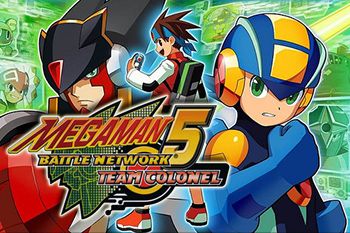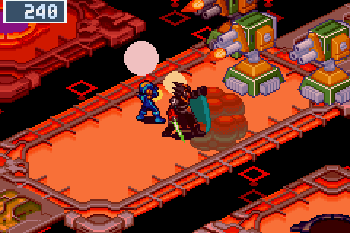

Each dark panel contains a group of viruses-so battles aren't random-but you can only liberate one panel per turn with each Navi. By using the Navis on your team, your goal is to liberate dark panels until you clear a path. Each level is filled with dark panels that block your way to the boss. Liberation missions are basically just turn-based variations of cyberspace levels. The main thing this fifth game does differently from its predecessors is give players the ability to alternate between multiple Navis (in addition to Mega Man) during so-called liberation missions. You can control multiple Navis during special liberation mission levels.

Even though the single-player mode lets you replay cleared missions and boss battles any time you like, it's still nice that the game gives you the option of interacting with live opponents. Like other games in the series, Mega Man Battle Network 5 supports the use of a link cable for linking together two GBA systems-so that people can trade chips, swap game data, and pit their Navis against one another in arena battles. In all, there are 287 unique chips to find and collect.

You can only bring 30 chips into battle with you, so that's where most of the game's strategy comes from: collecting, organizing, and storing useful battle chips in your active folder. Multiple attacks can be chained together by using chips with the same name or letter designation, and some chips can be combined to create stronger attacks by linking together three chips with the same name and sequential letter designations. Some chips are better against certain types of enemies, and some can dole out damage to a whole swath of grid squares. Five chips are randomly selected at the beginning of each battle, and when they're used, others are drawn to take their places. Apart from his buster cannon, the majority of Mega Man's attacks are contained on tiny cards known as battle chips. Instead of taking turns, like you would in a traditional role-playing game, you and your enemies can move and attack in real time. Battles still take place on a 6-by-3 grid that's split evenly into player and enemy areas. Often, the things you do in cyberspace will unlock doors or activate machines in the real world.Ĭapcom hasn't changed the way combat works. In them, Mega Man has to locate clues and find other Navis to talk to, and he also has to put up with frequently occurring random battles against evil Navis (called viruses). These environments are set up just like the dungeons in a traditional role-playing game. You can jack in to computers, household appliances, vending machines, toys, and all sorts of other Net-capable devices. Lan can enter homes, visit shops, take the train to different towns, and talk to people out in the real world, but his primary purpose is to find places where Mega Man can "jack in" to the Net. The stars of the show are a young boy named Lan and his souped-up cell phone, a Navi named Mega Man. Sometimes you have to deal with enemies on both sides.Ĭentral to every Mega Man Battle Network game is the idea that the real world and cyberspace exist as two separate universes.

#Megaman battle network 5 team colonel gamehacking series
On the other hand, it also retains the same graphics, audio, and basic game design that have been with the series since its inception roughly four years ago. On the one hand, Mega Man Battle Network 5 improves on the features that were introduced in the previous game and implements some new features that longtime fans should appreciate. Another year has gone by, and, like clockwork, Capcom has published the next installment in its Mega Man-themed role-playing-game franchise.


 0 kommentar(er)
0 kommentar(er)
